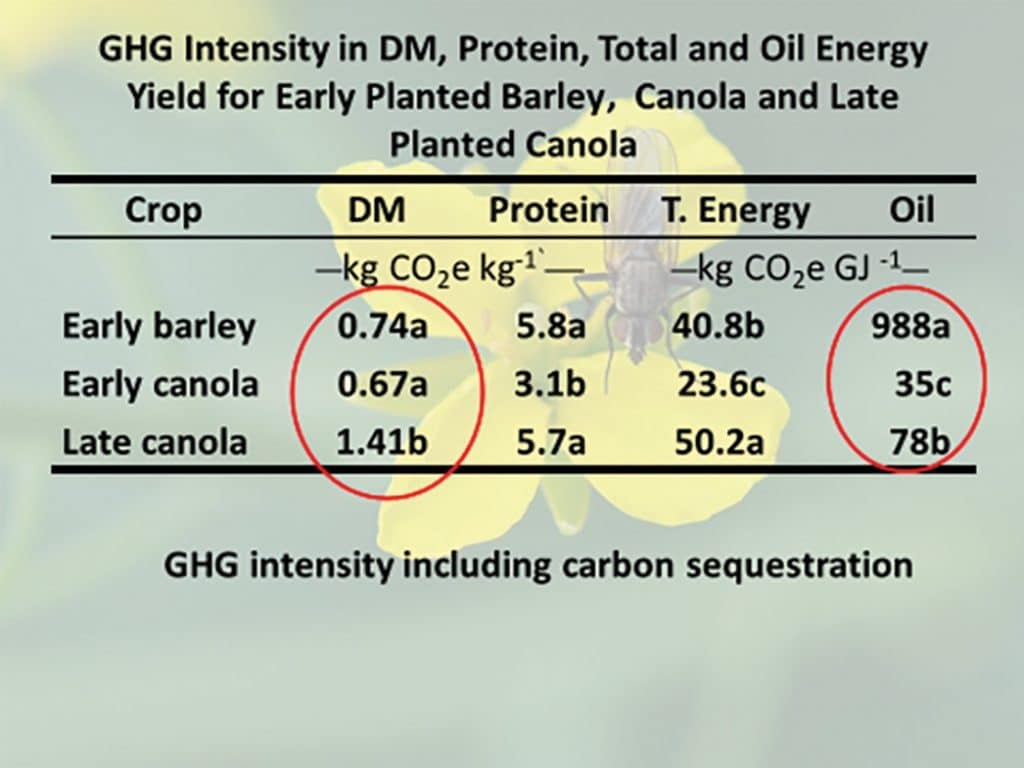Key Result
High-yielding canola with high inputs can be sustainable in an area in which it is adapted. Early-planted full season canola will provide the most sustainable “on-farm” footprint. Canola with high inputs can be the focal point of a crop rotation and can create economic flexibility to allow for a broad crop rotation plan.
Project Summary
PURPOSE: To estimate farm-gate canola carbon footprints in each soil zone and the greenhouse gas intensity for canola production using best management practices in a high-yielding, high-input region.
Note: this study build on research completed in the The environmental footprint of canola and canola-based products (part 1) project.
RESULTS: Research shows that if Canadian canola growers follow best practices for high-yielding early-planted canola, then their crop will have a lower carbon footprint.
Since 1990, the environmental profile of canola production per tonne has improved, largely as a result of increased yields and plant biomass from enhanced genetics (including herbicide tolerance (HT) and hybrid canola) and improved management practices.
In an industry-wide life cycle analysis (LCA) comparing canola greenhouse gas intensity between 1990 and 2010, researchers found that for canola produced in the Black Soil Zone of Alberta, nitrogen fertilizer inputs had increased from 71.6 to 97.2 kg N/ha, but N-use per tonne of seed yield had actually gone down slightly (57.7 to 54.6 kg-N/tonne of seed). That’s because average canola seed yield had increased from 1,242 to 2,032 kg/ha for black soils in Alberta over that time.

Researchers next addressed the question of “what is the role of a high-input high-yielding canola crop in a sustainable cropping strategy?” Their objective was to determine the carbon footprint of early- and late-planted canola and early planted barley on a field scale using prevalent “on-farm practice” in central Alberta. Over six years, they compared early-planted canola with high inputs (125 kg N/ha) to both early-planted barley and late-planted canola with lower inputs (80 kg N/ha). From an economic perspective, high-yielding crops in high-yielding areas require less land, enabling extended rotations. In the study, the land base required to net $100,000 was 442 acres for early-planted canola, 946 acres for late-planted canola, and 1,000 acres for the barley. Early-planted canola yielded on average 1,400 kg/ha more than late-seeded canola and overall provided more environmental benefits.
Researchers wanted to determine the greenhouse gas (GHG) intensity (including carbon sequestration) for canola production, and environmental impacts on a product intensity basis (i.e. GHG emitted per kg of seed or oil produced). The study showed that early planting provided the better (lower) GHG intensity. On a seed dry-matter (DM) basis, early barley and canola were lowest (best) and similar. Early-planted canola has a very low GHG intensity on an oil basis, with late-planted canola about 2.5 times larger, and early barley 10 times larger. Overall, on a protein, total energy and oil harvested basis, early planted canola with high inputs was the most sustainable crop management practice.
The carbon balance for all crops and planting dates on average was negative. Higher yielding early-planted canola removes more CO2 equivalent in the harvested oilseed crop, but also returns more in higher crop residues, with net carbon losses half of late-planted canola. Early-planted canola benefits as a full season crop, averaging 100 days of CO2 uptake (net photosynthesis and CO2 sequestration) compared to 84 for late-planted canola and 76 for barley. The system losses in carbon found in this field research project were similar on average to comparable losses in soil carbon predicted by the Century model, a computer simulation model, for these cropping practices. Overall, the research shows a high-input, high-yielding canola crop does play a big role in a sustainable cropping strategy.





